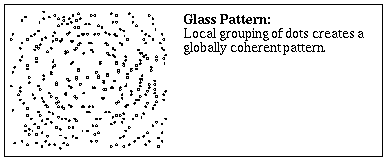Gabor Function
-
One Dimensional:

-
Two Dimensional:

-
Where the constant
 controls the standard
deviation (fall-off) of the function and the constant
controls the standard
deviation (fall-off) of the function and the constant  controls the spatial frequency.
controls the spatial frequency.

Ganglion Cell
-
Output neuron of the retina. Axons form the optic nerve. Divided into several
different classifications by morphological and physiological features for
cats and primates.
(See also On-Center Cells
and Off-Center Cells).
Morphological Classifications
-
Cat
-
 Cell
Cell
Correspond physiologically to Y Cells.
 Cell
Cell
Correspond physiologically to X Cells.
 Cell
Cell
Correspond physiologically to W Cells.
Primate
-
Parasol Ganglion Cell
Large cell bodies, large dendritic arborization. Correspond
physiologically to Magno Ganglion Cells.
Midget Ganglion Cell
Small cell bodies and small dendritic arborizations. Correspond
physiologically to Parvo Ganglion Cells
Bistrated Ganglion Cell
Carry signal of the short wavelength cones. Dendritic trees
stratified into two tiers near the inner and outer borders of the inner
plexiform layer. Send output to parvocellular layer of LGN.
Physiological Classifications
Cat
-
X Cell
Cells signals combine linearly, sensitive to local contrast
of image, respond poorly to uniform illumination of the receptive field,
spot moving in any direction gives rise to same response, a dim spot in
the receptive field will give rise to the same response as a smaller brighter
one. Primarily responsible for the cats contrast sensitivity at high spacial
frequencies. Separated into two classes, on-center and off-center cells.
Correspond mophologically to  cells.
cells.
Y Cell
Concentrically organized receptive fields in both on- and off-center
from. Receptive field 3x as large as X Cells. Show a pronounced non-linearity
in the summation of signals of from photoreceptors. Rectified on/off response
so cell discharge a burst of impulses at both the presentation and removal
of a contrast pattern. Mediate grating detection at low spacial frequencies.
Correspond morphologically to  cells.
cells.
W Cells
Correspond morphologically to  cells.
cells.
Primate
-
M Cell, Magno Cell, or P
 Cell
Cell
Receptive field 2-3 larger than P Cells. Show some non-linearities
like Y-cell in cat, but bulk are like X-cells. More sensitive to achromatic
contrast than P-cells. Transient response to sustained illumination. Appear
to work on gross features and movement. Send output to magnocellular layer
of LGN. Associated morphologically with Parasol Ganglion Cells.
P Cell, Parvo Cell, or P Cells
Cells
Similar to x-cells in cat but with color opponent organization.
Make contact with only a single bipolar cell. Wave-length selective. Two
main types, red-green chromatic opponency and yellow-blue chromatic opponency.
Mediate color and fine-detail. Send output to parvocellular layer of LGN.
Associated morphological with Midget Ganglion Cells.
Ganglion Cell Layer
-
(See Retinal Layers).
Ganzfeld Phenomenon
-
A uniformly illuminated surface of a uniform field (a ganzfeld) quickly
disappears from visual perception and one experiences a gray fog.
Gaussian Filter
-
Algorithm smoothing spatial or temporal variation in an image by averaging
neighboring values of light intensity, the contribution of values to the
average being weighted according to a Gaussian function.
Gaussian Function
-
One Dimension:

-
Two Dimensions:

-
Where the constant c controls the height of the gaussian and the
constant
 controls its standard deviation.
controls its standard deviation.

Gelb-Experiment
-
A spinning black disc is illuminated by a projector in a darkly illuminated
room. The disk appears to be white until a small white piece of paper is
placed in front of the projected light at which time the true color of
the disk is perceived (i.e. black).
Generalized Cone
-
(Marr & Nishihara 1978)
-
A surface representation created by moving a cross-section of a constant
shape but variable size along an axis.
Generic View
-
A view of an object that is not special. In other words, the view won't
change drastically with small perturbations in lighting or viewing direction.
(As opposed to Accidental View).
Geniculostriate Pathway
-
Pathway from the retina via the LGN to the striate cortex
Geons
-
(Biederman 1987)
-
Geometric ions. A set of basic shape primitive (wedges, cylinders)
from which complex objects can be described.
Gestalt Laws of Perceptual Organization
-
(Koffka 1935, Kohler 1947)
Proximity
Things which are close together are grouped together
Similarity
Things which look similar are grouped together
Common Fate
Things which appear to move together are grouped together
Good Continuation
Perceptual organization will tend to preserve smooth continuity
rather than yielding abrupt changes
Closure
Of several geometrically possible perceptual organizations
the one producing a closed rather than an open figure is preferred
Relative Size
Other things being equal, the smaller of two areas will be
seen as figure against a larger background
Surroundedness
Surrounded areas tend to be seen as figures as opposed to ground
Orientation
There is a preference for horizontal or vertically oriented
regions to be seen as figure
Symmetry
Symmetrical area tend to be perceived as figures against asymmetrical
backgrounds
Gestalt Psychologists
-
(Wertheimer, Kohler, Koffka)
-
The whole is greater than the parts
-
Law of Pragnanz
Of Several geometrically possible organizations the one that
will actually occur which posses the best, simplest and most stable shape
Doctrine of Isomorphism
Underlying every sensory experience is a brain event which
is structurally similar to that experience
-
(See also Gestalt
Laws of Perceptual Organization).
Glass Pattern
-
(Glass 1969)
-
If one takes a random set of dots and a slightly rotated copy of the same
set of dots, local groupings create a globally coherent pattern.

Glaucoma
-
A symptomatic condition characterized by raised intra-ocular pressure,
visual field loss, enlargement of the blind spot and changes in the appearance
of the optic nerve head. If left untreated ganglion cell axon death may
be caused by prolonged exposure of the eye to elevated introcular pressure.
(More Information)
Grouping, Perceptual
cells.
cells.
cells.